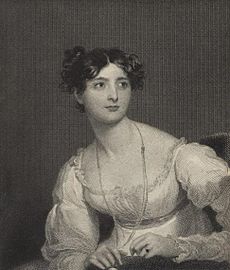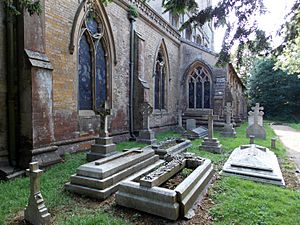Harriet Arbuthnot facts for kids
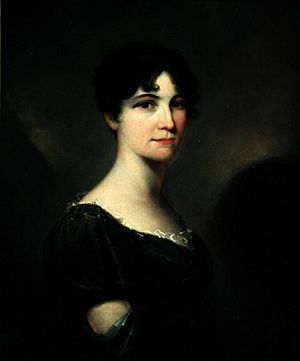
Harriet Arbuthnot (born Harriet Fane; 10 September 1793 – 2 August 1834) was an English writer and social observer in the early 1800s. She wrote a diary and hosted important political events for the Tory party.
In the 1820s, she became the closest woman friend of the Duke of Wellington, a famous hero of the Battle of Waterloo and later a British Prime Minister. She and the Duke wrote many letters to each other, and she wrote about their friendship in her diaries. Because of this, her diaries are very important for anyone studying the Duke of Wellington's life.
Harriet was born into a well-known family. Her parents were Henry Fane and Anne Batson. She married Charles Arbuthnot, a politician. This meant she met many important people from the Regency era and the time of the Napoleonic Wars. She wrote down conversations and events in great detail. Her diaries give historians a clear picture of what life was like for important people in Britain during that time. Her diaries were finally published in 1950 as The Journal of Mrs Arbuthnot.
Contents
Harriet's Early Life
Harriet Fane was born on 10 September 1793. Her father was the Hon. Henry Fane. He was the second son of Thomas Fane, the 8th Earl of Westmorland. Henry Fane was a Member of Parliament for Lyme. In 1772, he became the Keeper of the King's Private Roads.
In 1778, her father married Anne Batson, who was wealthy. Harriet's parents had 14 children: nine sons and five daughters.
Harriet spent most of her childhood at the family home, Fulbeck Hall in Lincolnshire. The house was given to Henry Fane by his father. It was a modern mansion that had been rebuilt after a fire in 1733. Her father also made it bigger and more modern in 1784.
Harriet's father died on 4 June 1802, when she was nine years old. The family's money situation got much better in 1810. Her mother inherited the Avon Tyrrell estate in Hampshire and the Upwood Estate in Dorset. This gave her mother an income of about £6,000 per year.
Harriet's Marriage
Harriet Fane married Charles Arbuthnot, a Member of Parliament, on 31 January 1814. The wedding took place at Fulbeck. Charles Arbuthnot was born in 1767, so he was 26 years older than Harriet. She was 20 when they married. This age difference made her family unsure about the marriage at first.
Another challenge was money. Harriet's widowed mother asked her older son, Vere, to help with the marriage arrangements. Vere worked at Child's Bank and was good with money matters. It seems Vere and his mother did not want to give Harriet enough money for her future husband to be happy. Charles Arbuthnot wrote to Harriet, asking how they could live on a small amount of money when her mother, who had much more, couldn't help them.
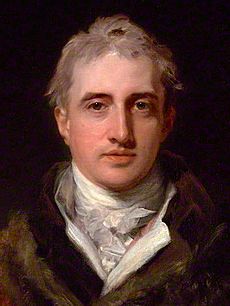
Charles Arbuthnot was a widower with four children. His son Charles was only nine years younger than Harriet. Charles Arbuthnot was a member of the Anglo-Irish upper class. He had been a Member of Parliament since 1795. When he married Harriet, he was the member for St Germans. He had also been an Ambassador to the Ottoman Empire from 1804 to 1807.
Marrying Charles Arbuthnot, who was such an important person, opened many doors for Harriet. As one of 14 children from a less wealthy part of an aristocratic family, she might not have met the highest levels of society otherwise.
Throughout her marriage, Harriet Arbuthnot became close friends with powerful older men. She called Lord Castlereagh her "dearest and best friend" until he died in 1822. After that, she became very close to the Duke of Wellington. People at the time agreed that her marriage was happy. Her husband was also a close friend of Wellington's.
Harriet was very interested in politics and enjoyed hosting political events. She worked hard to support Tory causes. Her husband worked for the Treasury and later was in charge of the Royal parks and gardens. This gave them access to the Royal family, which increased their importance in society.
Harriet's political observations in her diaries are written from her Tory point of view. However, her detailed descriptions of the power struggles between the Tories and Liberals from 1822 to 1830 are very important for understanding this time in history.
Friendship with Wellington
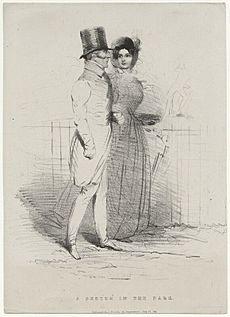
Harriet Arbuthnot likely first met the Duke of Wellington in 1814 in Paris. After Napoleon was sent away to Elba, Paris became a lively place again. Wellington was the British Ambassador to France, and many English visitors came to socialize.
The newly married Arbuthnots were among these visitors. Charles Arbuthnot knew Wellington, as he had supported Wellington's younger brother Henry during his divorce. It's also possible Wellington had heard of Harriet because she was a cousin to his favorite Burghersh family.
However, their close friendship really grew after Lord Castlereagh died in 1822. Wellington found comfort and happiness in Harriet's company. She became his trusted friend in all matters, especially about his marriage. He told her that he only married his wife because "they asked me to do it" and that he was "not the least in love with her." In fact, Wellington had not seen his wife for ten years before their wedding day. After they married, they found they had little in common and lived mostly separate lives until the Duchess of Wellington died in 1831. Harriet thought the Duchess was "a fool," but she also believed the Duchess wanted to make her husband happy, even if she didn't know how.
Because his marriage was not happy, Wellington formed friendships with other women, but he felt the deepest affection for Harriet Arbuthnot. Her husband was working at The Treasury, and Harriet became like Wellington's social secretary when he was Prime Minister from 1828 to 1830. It is thought that the Duke of Wellington allowed her to know many of the government's secrets. However, it seems she could not influence the Duke's decisions. Even when he refused to bring her husband into the government in 1828, their close friendship continued.
Wellington did not try to hide his friendship with Harriet. It was seen as a respectful, non-romantic friendship. For example, the Duchess of Kent allowed Wellington to introduce Harriet Arbuthnot to her young daughter, the future Queen Victoria, in 1828. Harriet wrote that the young princess was "the most charming child I ever saw."
Harriet and Wellington often traveled together. In 1824, they visited Blenheim Palace. Harriet wrote sharply about the 5th Duke of Marlborough in her diary. She said his family had "gone sadly to decay" and that the Duke was "overloaded with debt."
When Wellington and the Tories lost power in November 1830, Harriet lost interest in her diary. She wrote: "I shall write very seldom now... for, except the Duke, none of the public men interest me." Her account of the Tory party breaking up is very detailed and shows her strong support for the Tories.
Harriet's Legacy
Harriet Arbuthnot died suddenly from cholera on 2 August 1834. She was 40 years old. She died at Woodford Lodge, her home near Woodford House. A message was immediately sent to Apsley House, Wellington's London home.
After Harriet's death, it was revealed that she had been receiving a government pension of £936 per year since January 1823. Harriet Arbuthnot was buried in the Fane family plot at St Nicholas' parish church in Fulbeck.
The exact nature of Harriet's friendship with Wellington has always been a topic of discussion. It seems most likely that Harriet's presence helped protect Wellington from other women who tried to get close to him. The Duke did have other female friends during his friendship with Harriet, but there is no proof that Harriet was one of them. Today, tours at Apsley House, the Duke's London home, say that she simply served as his hostess for political dinners.
After Harriet's death, her husband, Charles, left Woodford House and lived with his close friend Wellington at Apsley House. The two elderly men mourned Harriet's loss and talked about the problems within the Tory party. Charles died there in 1850, at the age of 83. Wellington lived for another two years and was buried with great ceremony in St Paul's Cathedral.
See also
 In Spanish: Harriet Arbuthnot para niños
In Spanish: Harriet Arbuthnot para niños
- List of diarists



